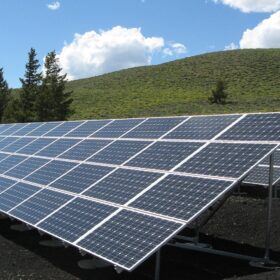The introduction of derivatives to India’s short-term power market will make it easier for renewable project developers to enter into offtake arrangements with the state-owned distribution companies (discoms), according to a new briefing note from the Institute for Energy Economics and Financial Analysis (IEEFA).
“The launch of new financial instruments will enable developers to hedge their offtaker risk without requiring the signing of long-term contracts with discoms for the financial closure of projects,” said author Vibhuti Garg, Energy Economist, Lead India at IEEFA.
Long-term (usually 25-year) power purchase agreements (PPAs) between power producers and discoms comprise 88% of electricity transactions in India. PPAs provide investors with the certainty of power offtake over a long duration and de-risk them from price volatility.
However, the Solar Energy Corporation of India (SECI) currently has 15-16 GW of auctioned capacity waiting to be signed by discoms. This backlog of unsigned PPAs is now impacting the development of new renewable energy projects.
Discoms are struggling with huge financial losses and have become increasingly reluctant to enter long-term PPAs with renewable energy developers as renewable tariffs hit a record low; solar tariffs in India dip to a new record low of INR 1.99/kWh at the end of 2020.
The electricity derivatives market in India is likely to take shape in 2021. Under the proposed structure, the physical delivery of electricity will be separated from the financial settlement.
Garg sees the sale of power in the futures market as a positive step that will help hedge the offtaker risk and provide flexibility and certainty of supply to both discoms and developers. This would also help develop the price signal needed to incentivize supply into peak demand periods, which is the key to enabling battery deployments and demand response management.
“Discoms with their power optimization tools can also participate in derivatives markets and hedge their risk. This will help discoms to lower their power purchasing costs and prevent them from being saddled with the inflexibility of long-term PPAs as electricity demand profiles change. Discoms will have the flexibility to buy power based on demand,” she added.
Under the proposed structure, long-term contracts in the physical (spot) market will be traded on power exchanges under the jurisdiction of the Central Electricity Regulatory Commission (CERC), while in the financial (derivatives) market contracts are set to be traded on commodity exchanges regulated by the Securities and Exchange Board of India (SEBI).
The physical and financial electricity markets will complement each other, according to Garg.
“A spot market at power exchanges and the derivatives market will feed into each other. It will be a virtuous cycle in which the derivatives market will establish forward prices, more participants will shift from PPAs to exchanges, increasing liquidity in derivatives and subsequently increasing liquidity in the spot market at power exchanges and vice versa.”
Financial products such as futures, options, and swaps don’t require physical delivery of electricity, so this opens up the market to hedgers, speculators, and other participants who can add liquidity without owning electricity assets.
“The financial market will increase trade volumes and will be lucrative for players including developers, discoms, open access buyers, traders, investors in the power sector and others who also have the ability to take on risk. It will also enable the sale of hybrid products. With an increasing share of renewable energy in the total generation mix, multiple products including wind, solar, and biogas, along with battery storage, are likely to see more demand,” said Garg.
The rollout of the financial market follows the launch last year of the Real-Time Market and the Green Term-Ahead Market.
This content is protected by copyright and may not be reused. If you want to cooperate with us and would like to reuse some of our content, please contact: editors@pv-magazine.com.









6 comments
By submitting this form you agree to pv magazine using your data for the purposes of publishing your comment.
Your personal data will only be disclosed or otherwise transmitted to third parties for the purposes of spam filtering or if this is necessary for technical maintenance of the website. Any other transfer to third parties will not take place unless this is justified on the basis of applicable data protection regulations or if pv magazine is legally obliged to do so.
You may revoke this consent at any time with effect for the future, in which case your personal data will be deleted immediately. Otherwise, your data will be deleted if pv magazine has processed your request or the purpose of data storage is fulfilled.
Further information on data privacy can be found in our Data Protection Policy.